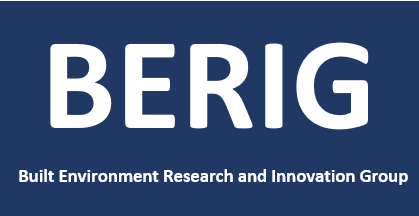Built Environment Research and Innovation Group
The Built Environment Research and Innovation Group (BERIG) is being formed as an intentionally multi-disciplinary group that will work with researchers, government bodies, the public sector, industry partners, and a range of professionals and trade bodies, to assist us all in advancing and improving our built environment.

The built environment relates to our surroundings that are built and directly modified by humans. This includes dwellings, buildings and the constructed spaces between them (e.g. paths, parks and the public realm) and the infrastructure that supports human activities (e.g. transportation systems, and utility networks). Therefore, with appropriate knowledge and application we can guide the development of the built environment to be more liveable and environmentally, socially and economically sustainable.
BERIG aims to grow the research culture and the level of positive impactful research activities of the built environment aligned researchers within the School of Design and the Built Environment using focussed, supportive and multi-disciplinary approaches and the support of FAD. As detailed below and following initial BERIG member discussions (with more planned), some research themes and activities have been proposed for further discussion and implementation.
It is recognised that the members of BERIG have diverse research backgrounds and levels of experience. As such, it is important that a supportive collaborative environment be develop and that early career researchers (ECRs) receive guided training to advance their academic careers. For this, BERIG will also work very closely with FAD and UC to ensure all opportunities are offered to the ECRs. As education forms an important part of an academic’s career members will also be encouraged to undertake research on improving learning and teaching in the built environment space.
Our vision is to support, inform and reform built environment systems and industries through integrated multi-disciplinary approaches.
(The 4 digit FOR codes that the below cover are in the areas of: 1201 Architecture; 1202 Building, 1203 Design Practice and Management; 1204 Engineering Design and 1205 Urban and Regional Planning. However, as the aim of the group is to encourage a multi-disciplinary approach it is expected that other codes will be positively impacted).
Themes
- Theme 1 - Role of smart and digital technologies in construction and urban transformations
- Theme 2 - A City in the Landscape - Canberra as an Urban Laboratory
- Theme 3 - Indigenous led design, planning and innovation
- Theme 4 - Built Environment Education Pedagogy
Name | Position | Contact/Profile |
| Charles Lemckert | Professor and Head of BERIG | View Profile |
| Steve Basson | Professor | Email Steve |
| Gevork Hartoonian | Professor | View Profile |
| Barbara Norman | Professor of Urban Planning | View Profile |
| Erin Hinton | Associate Dean of Education, Assistant Professor of Architecture | Email Erin |
| Hitomi Nakanishi | Associate Professor | View Profile |
| Michael Jasper | Associate Professor of Architecture. | View Profile |
| Max Maxwell | Associate Professor in Architecture | Email Max |
| Saeed Banihashemi | Assistant Professor | View Profile |
| Hamed Golizadeh | Assistant Professor | Email Hamed |
| John Ting | Assistant Professor - Architecture | View Profile |
| Milica Muminovic | Assistant Professor of Architecture | View Profile |
| Ann Cleary | Senior Lecturer | Email Ann |
| Lyn Norton | Lecturer in Interior Architecture | Email Lyn |
| Publications | |
|---|---|
| Pettit et al (2019) Geodesign - A Tale of Three Cities | |
| Nakanishi (2020) Children's travel behaviors and implication to transport energy consumption of household: a case study of three Australian cities | View Publication |
| Nakanishi et al, (2019) Investigating the flood evacuation behavior of older people: A case study of a rural town in Japan | View Publication |
| Pillai et al, (2019) Wave run-up on bermed coastal structures | View Publication |
| Spencer et al, (2019) Bottom Currents Affect Spanner Crab Catch Rates in Southern Queensland, Australia | View Publication |
| Muminovic, (2019) Place as Assemblage: Abstracting, Diagramming and Mapping | View Publication |
| Golizadeh (2019) barriers to adoption of RPAs on construction projects; a task-technology fit perspective | View Publication |
| Nakanishi, et al (2020) Simulating emergencies with transport outcomes SIM (SETOSim): Application of an agent-based decision support tool to community evacuation planning. | View Publication |
| Nakanish, et al (2020) One Earth; the Chaos after the Storm. | View Publication |

